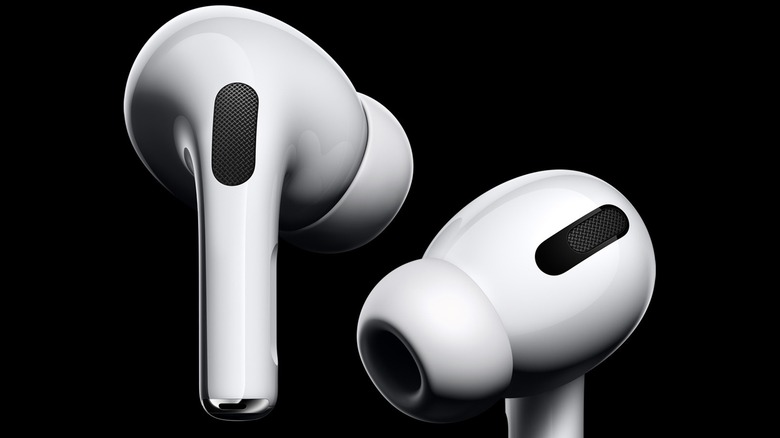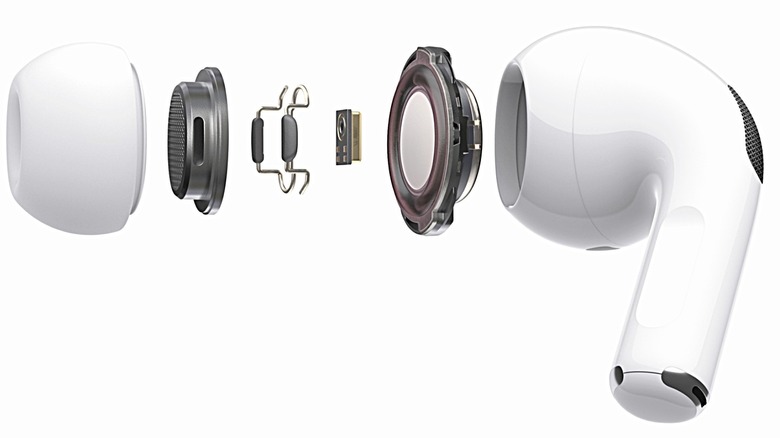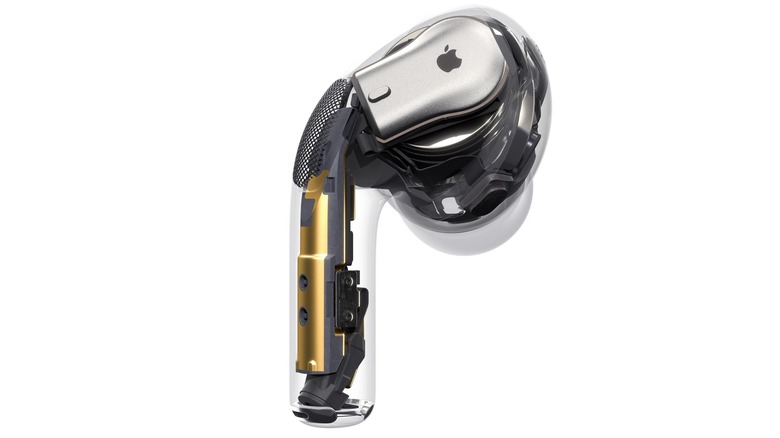The Reason Why AirPods Have A Vent, And Why You Shouldn't Block Them
Apple's AirPods are easy recognizable in a sea of true wireless earbuds, thanks to their signature stem design and vents on the outside. Over the course of three generations of AirPods history, Apple has toyed with the vent design and positioning to refine the audio performance. From a recessed look on the original AirPods and first-gen AirPods Pro, to a flush black strip on the second-gen AirPods Pro, the vent has changed forms but remained a mainstay.
However, it is not merely an aesthetic element. Instead, they serve a very important purpose for your music listening experience. Apple's official product page notes that these vents are used to equalize pressure and offer a more comfortable wearing experience. However, they also play an important role at improving the AirPods' best features, like transparency mode and active noise cancellation.
The vent's pressure equalizing activity, coupled with some clever software-level optimization, lets in some level of ambient noise while isolating the rest. This is done to ensure that you are able to listen to person talking or an important announcement, without totally getting lost in the noise. This system works better on the AirPods Pro than any other earbuds I've ever tried. Needless to say, these vents need to be taken care of.
The acoustic argument
Before we get to the importance of keeping the vents squeaky clean, let's go through the engineering behind them. Apple's own patent application for the AirPods filed in 2019 talks about "a rear vent that enable the internal speaker to provide audio performance in the confined space within the earbud housing." Fun fact: Apple's patent says that the vent's acoustic insert is made from "a carbon doped plastic that absorbs laser energy." It's unclear what kind of laser energy, exactly.
The vent actually serves as an important air flow channel from the outside. With the main speaker grill tightly sealed from the outside, the vents allow the movement of air in and out of the acoustic chamber. The acoustic chamber is where the driver sits, and it is the part that vibrates to produce the music you hear. Without proper airflow, the driver activity is adversely affected. Plus, they also help avoid the suction after the earbuds get a tight fit inside the ear canal.
If you cover the air vents on your AirPods, the music output will sound different, especially within the low and middle frequencies of sound. Apple's patent links the vents with changing "the frequency response of ear bud in a way that helps to tune the frequency response and/or provide a consistent bass response." Panasonic also mentions that the acoustic chamber "optimizes airflow to create a powerful bass and enhances sounds."
How to keep the vents clean?
Now that we know the importance of vents on the AirPods, it is imperative that you keep them clean. However, not many people clean their earbuds each day. Over time, ear wax, dust, and grime block the vent, interrupting the airflow and affecting the audio output, as well as the efficiency of transparency mode. There are plenty of complaints on the Apple community forum where users have discussed malfunctioning AirPods vents.
Here are a few steps that you can take to keep your AirPods' vents from getting clogged:
- Always use a lint-free fabric to clean your earbuds, especially the vent area.
- Do not put your AirPods under running water to wash away the dirt and grime. They are only water-resistant with an IPX4 rating, and even these protections won't last forever. To put it in plain words, keep your AirPods away from water sports and high velocity liquid streams.
- In order to remove stain-prone items like oil, conditioners, soap, or hair dye, try to clean the AirPods with a soft, damp piece of cloth. Make sure that the earbuds are completely dry before you put them back in the charging case.
- As for the mesh area, the best way to clean them is with a cotton swab. You can, however, take the ear tips off and wash them under running water, but avoid any chemical substance.
- If you're looking at alcohol-based cleaners, Apple suggests "a 70 percent isopropyl alcohol wipe, 75 percent ethyl alcohol wipe, or Clorox Wipes." But do keep in mind that these chemical cleaners are only for the external surface. You should stay from bleach and hydrogen peroxide at all costs.


